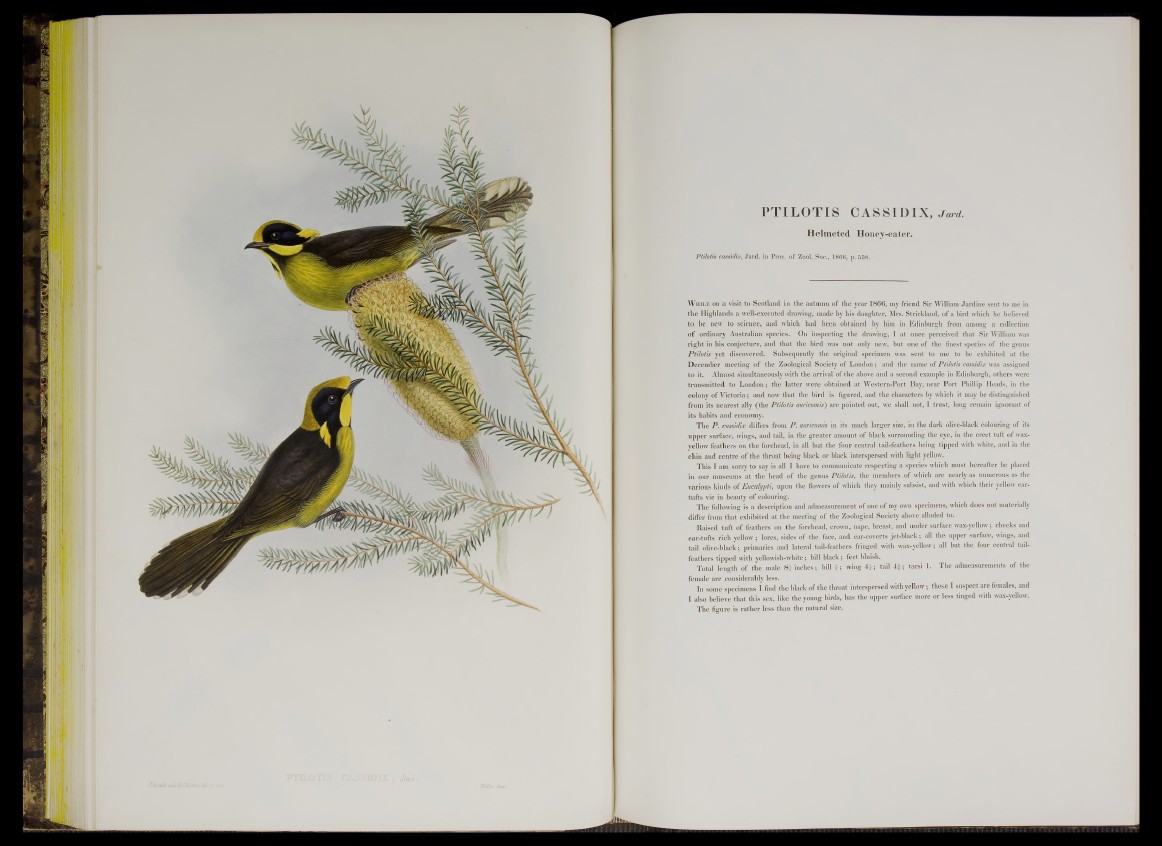
PTILOTIS CASSIDIX, Jard.
Helmeted Honey-eater.
Ptilotis cassidix, Jard. in Proc. of Zool. Soc., 1866, p. 558.
W hile on a visit to Scotland in the autumn of the year 1866, my friend Sir William Jardine sent to me in
the Highlands a well-executed drawing, made by his daughter, Mrs. Strickland, of a bird which he believed
to be new to science, and which had been obtained by him in Edinburgh from among a collection
of ordinary Australian species. On inspecting the drawing, I at once perceived that Sir William was
right in his conjecture, and that the bird was not only new, but one of the finest species of the genus
Ptilotis yet discovered. Subsequently the original specimen was sent to me to be exhibited at the
December meeting of the Zoological Society of London; and the name of Ptilotis cassidix was assigned
to it. Almost simultaneously with the arrival of the above and a second example in Edinburgh, others were
transmitted to London; the latter were obtained at Western-Port Bay, near Port Phillip Heads, iu the
colony of V ictoria; and now that the bird is figured, and the characters by which it may be distinguished
from its nearest ally (the Ptilotis auricomis') are pointed out, we shall not, I trust, long remain ignorant of
its habits and economy.
The P. cassidix differs from P. auricomis in its much larger size, in the dark olive-black colouring of its
upper surface, wings, and tail, in the greater amount of black surrounding the eye, in the erect tuft of wax-
yellow feathers on the forehead, in all but the four central tail-feathers being tipped with white, and in the
chin and centre of the throat being black or black interspersed with light yellow.
This I am sorry to say is all I have to communicate respecting a species which must hereafter be placed
in our museums at the head of the genus Ptilotis, the members of which are nearly as numerous as the
various kinds of Eucalypti, upon the flowers of which they mainly subsist, and with which their yellow ear-
tufts vie in beauty of colouring.
The following is a description and admeasurement of one of my own specimens, which does not materially
differ from that exhibited at the meeting of the Zoological Society above alluded to.
Raised tuft of feathers on the forehead, crown, nape, breast, and under surface wax-yellow; cheeks and
ear-tufts rich yellow; lores, sides of the face, and ear-coverts jet-black; all the upper surface, wings, and
tail olive-black; primaries and lateral tail-feathers fringed with wax-yellow; all but the four central tail-
feathers tipped with yellowish-white; bill black; feet bluish.
Total length of the male 8 i inches; bill £ ; wing 4 i ; tail 4 f ; tarsi 1. The admeasurements of the
female are considerably less.
In some specimens I find the black of the throat interspersed with yellow; these I suspect are females, and
I also believe that this sex, like the young birds, has the upper surface more or less tinged with wax-yellow.
The figure is rather less than the natural size.